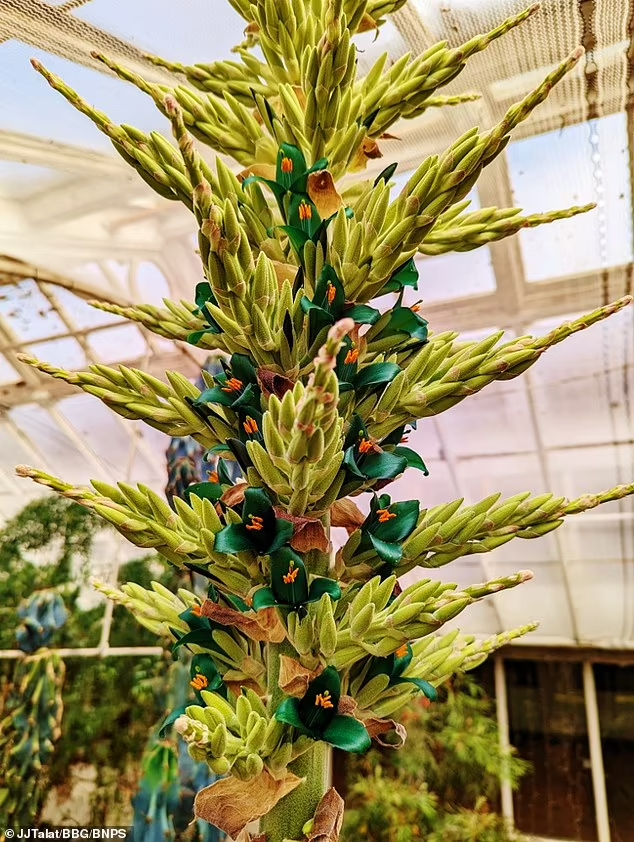Get ready to witness an incredibly rare and spectacular sight. At the Birmingham Botanical Gardens, a plant so extraordinary it’s been nicknamed the Sapphire Tower is blooming for the first time in a decade.
This “otherworldly” beauty from the Chilean Andes is a must-see, but you’ll have to hurry – these breathtaking blooms won’t last long.
What is the Sapphire Tower?
The Sapphire Tower, or Puya alpestris, is a fascinating and visually striking plant native to the Andean regions of Chile.
Part of the bromeliad family, which includes more familiar plants like pineapples and Spanish moss, Puya alpestris is particularly notable for its unique and vibrant characteristics.
Appearance and growth
The Sapphire Tower is characterized by its rosettes of silver-green leaves that are long, narrow, and edged with sharp spines.
The plant can grow quite large, typically reaching heights of up to a meter or more. It’s known for its dramatic flowering stalks, which can extend several meters high, far above the foliage.
The flowers themselves are what give the Sapphire Tower its name. They bloom in a striking metallic blue to turquoise color, and they are densely packed on the towering spikes.
These blooms are not only rare but also ephemeral, typically appearing only after many years of growth. The plant’s blooming cycle is particularly slow, often taking up to a decade to produce flowers.
Pollination and ecological role
In its native habitat in Chile, the Puya alpestris is adapted to being pollinated by birds, particularly hummingbirds.
The shape of the flowers and their arrangement on the tall spike are perfectly suited to facilitate bird pollination.
The coloration of the flowers is also believed to be an adaptation to attract these specific pollinators.

Sapphire Tower cultivation and care
Outside of its native range, cultivating Puya alpestris can be challenging. It requires well-draining soil, as it is adapted to the rocky soils of mountainous regions.
The plant prefers full sun and tolerates drought well. This is due to its ability to store water in its thick leaves, similar to other bromeliads.
In regions outside of Chile, the Puya alpestris is often grown in botanical gardens. It is also grown as an ornamental plant by enthusiasts who appreciate its dramatic appearance and rare blooming.
Pollinating the Sapphire Tower
Sapphire Towers rely on hummingbirds for pollination in their natural habitat. But in a botanical garden, dedicated horticulturists like Alberto Trinco step in to help nature.

“Each flower only lasts a few days, giving us a limited window of time to give nature a helping hand,” explains Trinco. “It is very slow-growing, so to witness its spectacular blooms is both exciting and rare.”
Their job is to carefully transfer pollen from one flower to another – a delicate process with a brief window for success.
Why pollination is important to Sapphire Tower plants
Pollination plays a vital role in the life cycle of plants such as the Sapphire Tower. This process is essential because it leads to the production of seeds, which are crucial for the propagation and survival of the species.
By transferring pollen from the male structures of one flower to the female structures of another, pollination initiates the development of seeds that will eventually grow into new plants.
For the Sapphire Tower, which blooms infrequently and only under specific conditions, successful pollination is particularly significant.

The seeds produced through this process ensure the continuation of the species, allowing it to thrive in its natural habitats.
These seeds carry the genetic blueprint of the plants, enhancing genetic diversity. This diversity is crucial for adapting to changing environmental conditions and resisting diseases and pests.
By preserving the species through natural reproductive processes like pollination, we ensure its survival. This allows future generations to enjoy and appreciate the extraordinary beauty of the Sapphire Tower.
The plant’s unique characteristics and striking appearance make it a valuable specimen for botanical gardens and plant enthusiasts.
Thus, effective pollination not only supports the ecological balance in the plant’s native environment but also enhances human appreciation and understanding of biodiversity.
Don’t miss this “exquisite” Sapphire Tower bloom
If you’re lucky enough to be near the Birmingham Botanical Gardens, you have a chance to witness this breathtaking sight for yourself. But don’t wait too long! You might only have between 10 days to two weeks to experience it.
The Sapphire Tower serves as an incredible reminder of our planet’s amazing biodiversity. Slow-growing marvels and fleeting, vibrant blooms fill the natural world with delicate and awe-inspiring wonders.
Interesting facts on Sapphire Towers
Here are some other fascinating facts about the Sapphire Tower to amaze your friends and family:
Distant relatives
Bromeliads are the same plant family as pineapples. It’s hard to imagine the spiky, alien-like Sapphire Tower is related to our favorite tropical fruit, but it is.
This family, known for their rosette shape and central “tank” formed by their tightly overlapping leaf bases, showcases a wide variety of forms and adaptations, highlighting the diversity of the bromeliad family.


